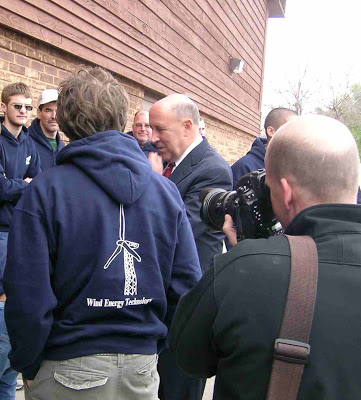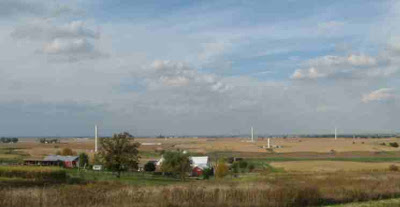by jboullion | Nov 1, 2008 | Uncategorized
From a presentation on barriers to project siting by RENEW Executive Director Michael Vickerman for the Wisconsin Wind Wroking Group in November 2008.
The Ultimate Irony
It is easier to obtain a permit from the State of Wisconsin for a 100-turbine project than one from a township board for a one-turbine installation.
However, seeking state approval is an expensive, time-consuming, and lawyer-intensive process.
by jboullion | Oct 30, 2008 | Uncategorized
From an article by Jeff Anthony, American Wind Energy Association and RENEW Wisconsin board member:
. . . While wind energy is becoming a mainstream source of electricity in the U.S., with a realistic potential of powering 20% of our electric needs by 2030, its ability to play a key role in powering PHEVs [plug-in hybrid electric vehicle] makes for an even brighter future for the clean, renewable energy source. . . .
With widespread deployment, the impact of PHEVs on the transportation sector and the nation would be massive. A study by the Pacific Northwest National Laboratory found that replacing 73% of the U.S. light-duty vehicle fleet with PHEVs would result in a reduction in oil consumption of 6.2 million barrels a day, cutting the need for imported oil by about 50%.
But what would such a heavy reliance on electricity generation for transportation purposes do to aggregate power plant emissions? A joint study by the Electric Power Research Institute (EPRI) and the Natural Resources Defense Council found that if 60% of light vehicles in the U.S. were replaced by plug-in vehicles by 2050, electricity consumption would rise only about 8%. The net gain from significantly reducing oil use for transportation—while only marginally increasing the use of fossil fuels to produce electricity—would translate into net carbon dioxide reductions of 450 million metric tons annually—equivalent to taking 82 million cars off the road. And when you bring wind power into the equation, the news gets even better: if the renewable energy resource contributes a greater share to the electricity supply mix that ultimately would recharge the PHEV fleet, any increase in emissions from greater electricity usage can be cut dramatically, making the net emissions reduction even lower.
The primary reason PHEVs result in significant net emissions reductions is that electric motors are several times more efficient than gasoline internal combustion engines. EPRI estimates that while charging, PHEVs will draw only 1.4 kW-2 kW—about the same as a dishwasher. Moreover, in a transportation world that includes many PHEVs, electric rates are likely to be designed to ensure that vehicle charging occurs almost exclusively at night, guaranteeing that PHEVs will use low-cost electricity—while not imposing additional strain on the electric grid during daytime hours of peak electricity usage. And wind energy fits ideally into that part of the equation for another reason as well: wind power output is typically highest at night in many parts of the country. . . .
by jboullion | Oct 27, 2008 | Uncategorized
From a media release issued by Focus on Energy:
Focus on Energy, Wisconsin’s energy efficiency and renewable energy initiative, announced today that Oakdale Electric Cooperative officially became a program member beginning October 1, 2008. The utility serves approximately 15,000 customers throughout Monroe and Juneau counties and portions of Jackson, Sauk and Wood counties. . . .
Oakdale Electric Cooperative will participate in the Business, Residential and Renewable Energy offerings under the Focus on Energy umbrella. The benefits of participating include:
· Business Programs that help manufacturers, commercial businesses, farmers, schools and local governments reduce operating costs, increase their bottom line and improve productivity and employee and customer comfort. The programs offer technical expertise, training and financial incentives to help implement innovative energy management projects.
· Wisconsin ENERGY STAR Homes, Home Performance with ENERGY STAR and Apartment & Condo Efficiency Services Programs that encompass new and existing homes,
multi-family construction and remodeling projects for all types of residential dwellings. These programs help homeowners and landlords integrate energy improvements into their remodeling projects, as well as deliver newly-built homes, apartments and condominiums that are comfortable, safe, durable and energy efficient.
· Lighting and appliance programs that increase the availability of ENERGY STAR qualified products ranging from compact fluorescent light bulbs to heating and cooling equipment. These efforts deliver lower energy bills for residents and businesses and increased sales for retailers and contractors.
· Renewable Energy Programs that help residents and businesses harness energy from sunlight, wind and organic materials.
· Targeted Home Performance that reduces energy bills while increasing comfort and safety for income-qualified participants

by jboullion | Oct 27, 2008 | Uncategorized

Govenor Doyle chatted during the dedication program with students from Lakeshore Technical College’s Wind Energy Technican program.
A report from Jeff Anthony of the American Wind Energy Association (AWEA):
At the first wind project dedication ceremony for a major wind project in the state of Wisconsin in over seven years, Governor Jim Doyle (D) and other state government officials dedicated the Forward Wind Center in Brownsville, WI. Governor Doyle gave remarks at the ceremony on Wednesday, October 22, 2008 at the Brownville Community Center, noting that “the project represents a clean energy milestone for Wisconsin, meaning greater energy security, better wages in green jobs, and clean air and water for generations to come”. He also emphasized that in the economic turbulence “clean energy future greater investment, more jobs, and more security at home”.
A global warming task force commissioned by Governor Doyle issued a report in August recommending that Wisconsin accelerate its Renewable Energy Standard targets, achieving 10% by 2013, 20% by 2020 and 25% by 2025. Governor Doyle also reiterated his intent to pass the enhanced RES in the 2009 legislative session to require state utilities to get 25% of their electricity from renewable energy such as the energy produced by the Forward Wind Center by the year 2015. He also called for the great manufacturing capabilities in Wisconsin to be directed towards clean energy technologies such as wind power as well.
Michael Polsky, President and CEO of Invenergy, welcomed an over-flowing crowd to the project dedication ceremony and described the benefits of wind power, saying “It just makes sense” from so many different perspectives, including energy security, long-term clean energy production, and environmental benefits. Tours were conducted throughout the afternoon by developer Invenergy, the project owner and operator. The output of the project is under contract to four Wisconsin utilizes: Madison Gas & Electric, Wisconsin Public Service, Wisconsin Power & Light (Alliant Energy), and Wisconsin Public Power, Inc. The Forward Wind Center consists of 86 General Electric 1.5 MW wind turbines (for a total of 129 MW) covering 12,000 acres in Dodge and Fond du Lac counties in Southeastern Wisconsin. Commercial operations at the facility began in March 2008, the project is expected to produce enough energy to power 30,000 homes and avoid the burning of 187 million pounds of coal per year. The Forward wind project is one of four major wind projects schedule to come on-line in 2008, representing a major step forward for the state of Wisconsin.
More from an article by Aubrey Fleischer in The Reporter (Fond du Lac).

by jboullion | Oct 22, 2008 | Uncategorized
 Towers await turbines at EcoEnergy‘s EcoGrove wind project near Lena, Illinois.
Towers await turbines at EcoEnergy‘s EcoGrove wind project near Lena, Illinois.


